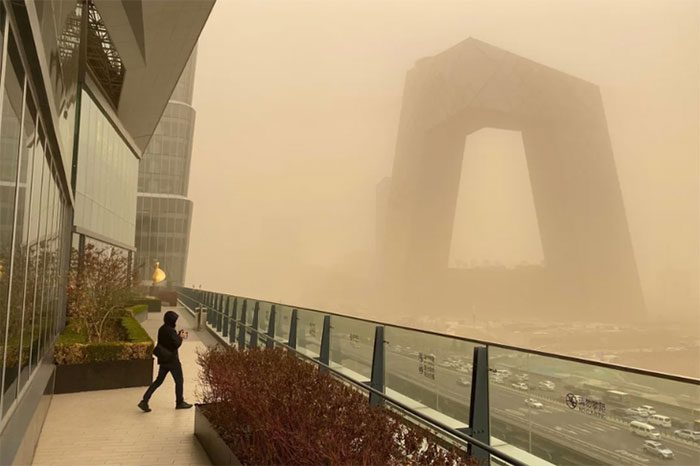Approximately 2 billion tons of dust enter the atmosphere each year, darkening the sky and harming air quality in areas thousands of kilometers away.
On October 19, the World Meteorological Organization (WMO) of the United Nations released its annual report, examining the frequency and severity of dust and sandstorms, as well as their impacts on society.

Buildings in central Beijing engulfed in a sandstorm on March 15, 2023 – (Photo: AFP).
According to this updated report, the average annual surface dust concentration worldwide last year was 13.8 micrograms per cubic meter (mcg/m3), slightly higher than the 13.5 mcg/m3 recorded in 2021. This slight increase is attributed to rising emissions from Central and West Africa, the Arabian Peninsula, the Iranian Plateau, and northwestern China.
The report also notes that the highest average annual surface dust concentration was recorded in the Bodele region of the Republic of Chad, ranging from 900 to 1,200 mcg/m3. In the Southern Hemisphere, the highest concentrations measured in central Australia and the southwestern coastal region of Africa were approximately 200-300 mcg/m3.
Furthermore, the report states that about 2 billion tons of dust enter the atmosphere each year, darkening the sky and negatively impacting air quality in areas thousands of kilometers away, while also affecting economies, ecosystems, weather, and climate.
The report details three major incidents in 2022, including an unusual dust storm in March when a hot air mass from the Sahara Desert swept into several areas of Spain, bringing dust and sand that turned the sky orange.
At that time, in southwestern Spain, the highest hourly dust levels reached 3,500 mcg, far exceeding the European Union’s (EU) daily average dust limit of 50 mcg.
|
Human Activities Increase Dust and Sandstorms In the report, WMO Secretary-General Petteri Taalas emphasized that human activities are influencing dust and sandstorms. Specifically, higher temperatures, drought, and increased evaporation have led to lower soil moisture. These factors, combined with poor land management, have created conditions for more frequent dust and sandstorms. Dust and sandstorms impact health, air traffic, ground transportation, roadways, railways, and agriculture. This affects public health, safety, and the economy. In light of these realities, WMO calls for further research on sandstorms, dust, and climate change, issues that largely remain “unexplored.” The organization also expressed a desire for early warning systems for weather-related disasters to be implemented worldwide within the next four years, to protect people from the increasingly severe impacts of climate change. |


















































